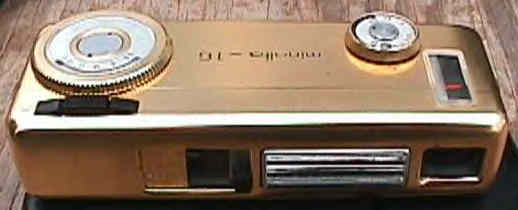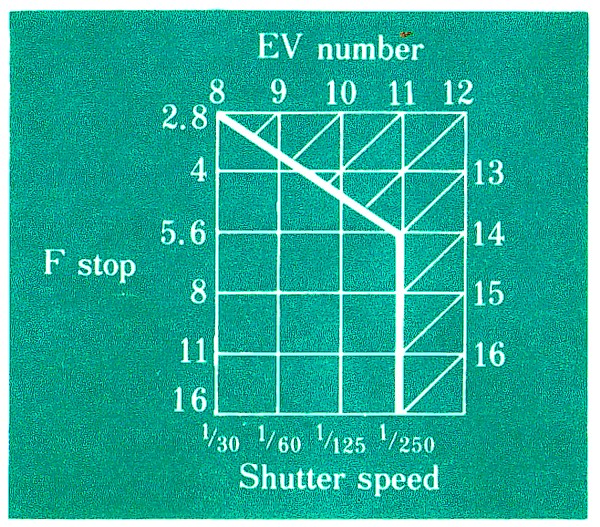

Minolta 16 MG
By 1966, Minolta found that their submini line of cameras was going in two different directions. While
their original 16mm cameras were tiny, their new, automatic-exposure cameras were large and heavy. They decided
to solve this discrepancy by producing the MG -- a new 16mm camera with a built-in meter that was actually smaller
than their original camera! This camera was very much a return to the original purpose of the original
Minolta 16 -- to have a convenient camera that was very small. But it added substantial features over the original
and it now included a built-in meter. Both the Minolta P (1960) and EE (1962) cameras had grown substantially
in size and weight over the original Minolta 16 model as they added features, such as a built-in meter and automatic
exposure. But the MG reverted back to a much smaller body -- and a very stylish body it was! So how
could they do it? Something had to give, and it was the CDS meter and automatic exposure. The Minolta
EE included automatic exposure and the EE2 used a CDS meter system with a battery. The MG dropped the CDS
meter and reverted back to a selenium meter -- which does not require a battery -- saving much needed space. They
also saved space by dropping the automatic exposure system, but came up with a system that makes the camera more
versatile and almost as easy to use. The MG has manual exposure settings -- which the EE cameras lacked --
and it has a special match needle exposure system that's almost as convenient as automatic exposure. In fact, the
MG metering system is so easy to use that it is often listed as having auto-exposure!
It's really a match-needle system which adjusts the shutter speed and aperture in combination -- at the same time. Think of it as a programmed, metered-manual exposure system. Just dial in the film speed (ISO 25 - 400) and then turn the "exposure" dial until the needles match in the exposure window on the top of the camera. This lets you quickly set the correct exposure settings, but the camera can be used manually for creative control.
Manual exposure settings take a little getting used to as they cannot be set independently. The camera adjusts the f-stop and shutter speed at the same time, so that at 1/30 the f-stop is f2.8, while at 1/250 the f-stop is f16. But with a little practice, manual settings are not difficult to make. The MG programmed settings are "shutter-preferred programmed". In other words, from the f-stop settings from f16 down to f5.6, the shutter speed remains at 1/250s. This helps prevent blurred pictures. Below f5.6, the shutter speed drops about 1.5EV for each full f-stop change. So, when using f4 or f2.8, it's important to hold the camera steady, and keep the subject as close to 10 feet away as possible (4 feet, if using the close-up lens).

The camera has a slightly-wider lens than the earlier cameras -- a 20mm f2.8 lens. It's a four-element optic so the results are super-sharp. The focus is fixed at 10 feet; and with the wider 20mm lens, and using of the variable aperture, the depth-of-field was quite substantial. Shutter speeds of 1/30-1/250 and f-stops from f2.8 - f16. Only two filters were available -- UV and Y48 (yellow) -- but a creative person can make their own by attaching gelatin filers behind the UV filter. The camera did have the convenience of a built-in, sliding close-up lens (set to four feet) -- so no additional close-up lenses were needed -- and parallax marks are visible in the viewfinder. A red mark appears in the viewfinder when the close-up lens is in place to avoid out-of-focus pictures. It also appears when the built-in lens cover is in place -- which locks the shutter release (although it does not turn off the meter). The camera does not have a flash shoe. A flash gun, which matches the very stylish body, was available and used flash bulbs. The accessory flashgun screwed into the tripod socket of the camera, and has an additional tripod socket should it be needed. The camera had a PC contact which the accessory flashgun did not use, so other flash units could be used with the camera, as well. To use flash, there is a flash switch on the back of the camera that sets the shutter at 1/30. Then you select the f-stop manually -- a setup that's perfect for low light, non-flash pictures, as well. Not only was the MG small and stylish, it has a silky-smooth finish that feels almost natural in your hand. Many subbers fall in love with this camera for this reason, even before seeing the great results. Most models were chrome, but a gold version was also made. The MG was also sold as the Revue 16 and was produces until 1971.
COPYRIGHT @ 1995-2025 by Joe McGloin. All Rights Reserved.